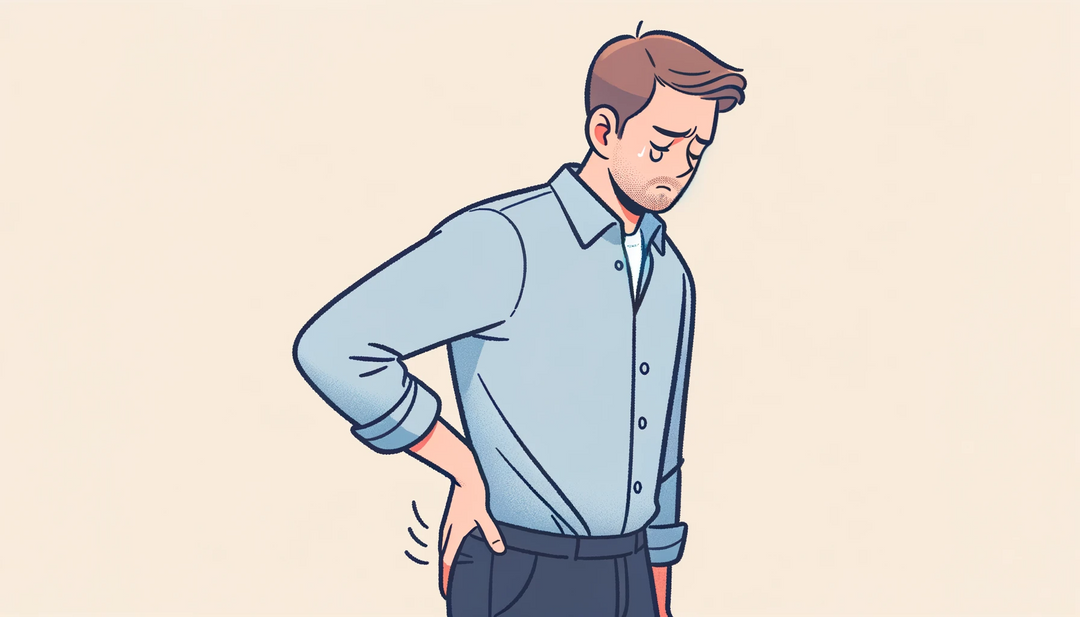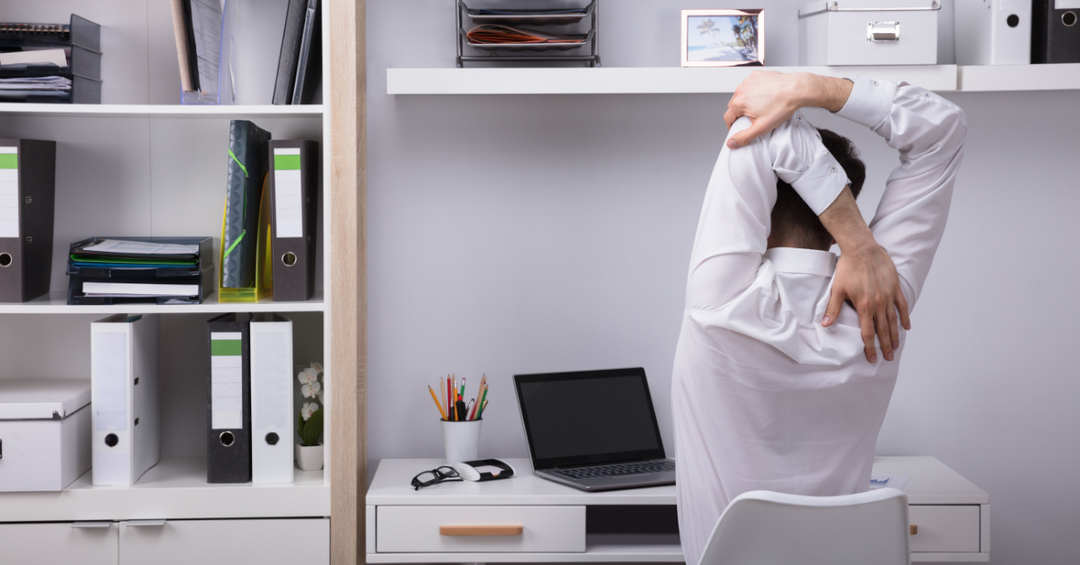The Best Standing Desk Chair for Sciatica
‘Sciatica’ is the name given to discomfort and pain resulting from irritation (often pinching) of the sciatic nerve. Experts report that 40% of people will suffer it in their lifetime.
In severe cases, sciatica can be debilitating. No two episodes look alike. The pain may start as tingling, numbness, burning, weakness, or a general feeling of discomfort in the lower limbs. And, if not treated, may grow into a dull to sharp pain radiating along the entire sciatic nerve. In some cases, the onset of sciatica can be sudden, escalating to a stabbing pain within a moment.
The reason sciatica is so serious, regardless of a person’s unique case, is that the sciatic nerve is the largest in the human body. It branches from the lower back through the hips and down each leg. Irritation of it creates pain and discomfort in the entire lower body, from the lower back down.
Sitting is the enemy for sciatica sufferers
“People who sit for long periods and are physically inactive are more likely to develop sciatica, compared with active people.”-Medical News Today
Potential causes of sciatica include a herniated disc, muscle spasms, or degeneration of tissue in the lumbar spine. Many doctors report that chronic sitting may be a primary cause in some cases. Incidentally, in the majority of sciatica flare-ups and episodes, sitting also makes the pain worse.
“If you have sciatica — pain down the leg — it’s often times from a disc or a low back problem which very commonly is worsened or made worse from long-term sitting or sitting with poor posture”-Brad Heineck, PT, C.S.C.S.
Because of this, patients are often told they need to leave the sitting desk behind and start using a standing desk. But the reality of transitioning to a standing desk when you suffer from sciatica often isn’t pretty. Most people find that prolonged periods of standing — without any support — is just as painful as prolonged periods of sitting.
The LeanRite™ standing chair: the support sciatica sufferers need to work at a standing desk comfortably

Also called a perching stool, standing height stool, mobile standing chair, or height-adjustable stool, a standing desk chair is a chair designed to make standing work comfortable and energizing. Our blog post What IS a standing desk chair? (5-minute read) explains the design and function of a quality one, using our own LeanRite™ Elite as a model.
To our delight, we’ve received numerous reviews from customers reporting that the LeanRite™ Elite was very helpful in helping them deal with their sciatica pain. One of our Amazon customers even wrote in a review that the LeanRite™ “cured” their sciatica “in less than two weeks” — after having suffered with it for seven months. This influx of sciatica-related comments compelled us to dig a little bit deeper into the research and feedback, isolating each way a chair like the LeanRite™ can help ease, heal, and prevent sciatica.
7 Criteria: the best standing desk chair for sciatica pain
If you’re shopping the market now for a standing desk chair to help with your sciatica, consider the following design features and how they may support your needs as you transition to a standing desk. We expand on each of these seven design features below, with pictures for reference.
-
Provides ‘standing support’ (to the glutes and lumbar region) to make the transition to standing more comfortable
-
Braces your lower back at the ideal spot (through adjustable lumbar support) to ease sciatica pain
-
Guarantees fine-grain control over the distribution of your weight through precise adjustability of seat pitch and chair height
-
Supports your spine and pelvis in neutral positions, relieving pressure on the sciatic nerve
-
Pairs well with an ergonomic footrest
-
Supports you in a ‘perching’ or ‘leaning’ posture — a hybrid sit-stand posture proven to reduce low back pain
-
Adjusts effortlessly and dynamically to support multiple positions, encouraging movement
Provides ‘standing support’ (to the glutes and lumbar region) to make the transition to standing more comfortable
“When a person's body has learned through muscle memory to move in an incorrect posture, unhealthy walking and sitting patterns begin to form and take shape in the body, which can really irritate the sciatic nerve. Poor posture can lead to the development of bulging or herniated spinal discs, which can certainly cause spasms that lead to sciatic nerve pain and even damage.”-The Joint Chiropractic
Poor posture is another leading cause of sciatica pain. This is important to bear in mind as you shop for a standing desk chair because the root of bad posture is weak core muscles. So you’ll, of course, want to develop core strength — and your standing chair can actually play a significant role in helping you strengthen your core muscles as you stand.
Take the LeanRite™ standing desk chair, which provides you support as you stand (lumbar support or glute support depending on the chair’s position). ‘Standing’ support allows you to ease into standing work and develop your core muscles over time. Without this kind of support, working at a standing desk will be exhausting and uncomfortable, if not purely painful.
"I will stand up tall and lean up against it while I'm working — it keeps me engaging my core..."-Katelin Rodriguez, LeanRite™ Elite user
Braces your lower back at the ideal spot (through adjustable lumbar support) to ease sciatica pain


Fine-grain control over the distribution of your weight through precise adjustability of seat pitch and chair height for ultimate comfort
“...in order to have any impact on sciatic nerve pain, an office chair needs to allow for a high degree of fine-tuning where its ergonomic features are concerned. This is especially important where lumbar support is concerned, but in truth, the more adjustable ergonomic features a chair has, the more benefit it’s going to provide to the person sitting in it.”-The Chair Institute’s Best Office Chair for Sciatica Nerve Pain 2019 guide criteria
In the video, Cody Meltzer, a happy user of the LeanRite™ Elite, talks about his experience with the product. He switched to a standing desk but needed a supportive chair to complete the setup. He shares his disappointment with other chair models from leading furniture brands and eventually finding the LeanRite™ — the perfect, hybrid sit-stand chair with fine-tune adjustment that he was looking for.
He emphasizes the LeanRite™’s fine-tune adjustability:
Supports your spine and pelvis in neutral positions, easing pressure on the sciatic nerve
—> Watch Dr. Sevim’s full review of the LeanRite™ Elite by clicking here
Pairs well with an ergonomic footrest, a criterion for a good chair for sciatica pain
“One of the best ways to keep your pain at bay and stay productive is to be able to shift and adjust your seating position throughout the day… chairs offering extras such as an optional footrest or dynamic, proprietary support systems were given additional consideration.”-The Chair Institute’s Best Office Chair for Sciatica Nerve Pain 2019 guide criteria
A footrest offers comfort and overall ergonomic benefit. It allows you to shift weight between feet, keeping the leg muscles engaged and circulation healthy. Improved blood flow can do wonders for sciatica pain and discomfort. A footrest also makes a perching, leaning, or standing posture easier on the lower back while offloading some of the pressure on the legs and feet.
It also affords you the option to rest, flex, and stretch calves, ankles, and simply alternate your working postures in more ways. With sciatic nerve pain, this kind of movement can be an extraordinary healer.
—> Learn more: why the Ergo Impact team considers a footrest an essential accessory to every desk (9-minute read)
As a bonus, the LeanRite™’s integrated foot cushion takes even more pressure off the body.
Supports you in a ‘perching’ or ‘leaning’ posture — a hybrid sit-stand posture proven to reduce low back pain by taking some pressure off of the spine
—> 5-minute Read: Is Perching the New Sitting? Research Suggests Yes.
Adjusts effortlessly and dynamically to support multiple positions, encouraging the movement that eases, heals, and prevents sciatica
“While sciatica is healing, try to remain active. Motion can actually help reduce inflammation and pain”-Webmd
An office chair must be highly adjustable to help relieve and prevent sciatic nerve pain. This is according to the Chair Institute — a team of chair-enthusiast researchers that intensively review chairs of every class. We were thrilled to read this because adjustability is the LeanRite™ Elite’s strongest selling point. Its sturdy post is height adjustable, and its comfortable seat pan is angle/tilt adjustable. Together, the post and seat pan adjust dynamically to support the body in a variety of working postures, sit to stand.The marathon toward better health
“Core strengthening is an important preventative and long-term care measure for sciatica, improving muscle strength, posture, and flexibility. Once symptoms of sciatica are alleviated, a core strengthening regime can begin.”-Relax the Back.
The transition to standing can be a slow one depending on the health of your body’s mechanics. It’s important not to let discouragement (or lack of chair support) prevent you from making the change. Because once you complete the transition to a standing or sit-stand desk, you’ll be strengthening your core muscles during the periods that you work out of the day, rather than slackening and weakening them all day long, making your condition worse.










Leave a comment